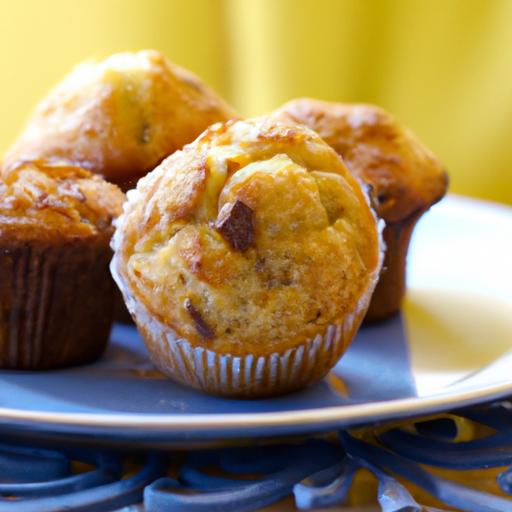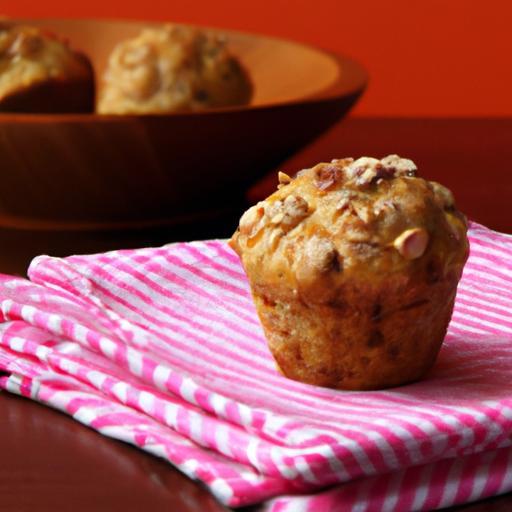There’s a certain magic in baking muffins-a simple dance of flour, eggs, sugar, and butter coming together to create soft, tender delights. Yet, amid this alchemy, one misstep can transform your golden dreams into dense, chewy disappointments. Enter the notorious muffin mix-up: what really happens when you over-mix the batter? Beyond just a ruined batch, this common baking blunder unlocks a fascinating world of science and texture that every baker, novice or pro, should understand. Let’s dive into the curious chemistry behind over-mixing and uncover how a little too much stirring can turn your muffins from fluffy masterpieces into tough little puzzles.
The Muffin Mix-Up: What Happens When You Over-Mix?
The Muffin Mix-Up: What Happens When You Over-Mix? is a journey into the delicate balance of muffin batter science that every baker must master. Muffins are comfort in crumb form, yet their tender texture depends on one key technique: the perfect mixing of ingredients. Too vigorous, and you risk a rubbery, dense disaster; too gentle, and you might end up with uneven pockets of flour. Understanding how gluten develops and how it affects muffin batter will empower you to bake muffins that are irresistibly soft, fluffy, and bursting with flavor.
Prep and Cook Time
- Preparation: 15 minutes
- Baking: 20-25 minutes
- Total Time: 40 minutes
Yield
12 standard-sized muffins
Difficulty Level
Easy to Medium – Perfect for bakers of all levels
Ingredients
- 2 cups all-purpose flour, sifted
- 3/4 cup granulated sugar
- 2 tsp baking powder
- 1/2 tsp baking soda
- 1/4 tsp salt
- 1 cup buttermilk, room temperature
- 1/2 cup unsalted butter, melted and cooled
- 2 large eggs, beaten
- 1 tsp pure vanilla extract
- 1 cup fresh blueberries (optional for added charm)
Instructions
- Preheat your oven to 375°F (190°C) and line a 12-cup muffin tin with paper liners or grease it lightly.
- In a large bowl, whisk together all dry ingredients: flour, sugar, baking powder, baking soda, and salt. Take a moment to notice the fine texture of your sifted flour forming the base for your muffins.
- In a separate bowl, combine the buttermilk, melted butter, beaten eggs, and vanilla extract. Mix gently until evenly blended, but avoid vigorous stirring to preserve the tenderness in the final crumb.
- Add the wet ingredients to the dry mixture and fold gently together using a spatula or large spoon. The goal is to mix just until no dry streaks remain; a few small lumps are perfectly okay.
- Fold in the blueberries carefully – berries clustered in batter pockets can cause heaviness if over-mixed.
- Divide the batter evenly into the muffin cups, filling about 2/3 full.
- Bake for 20-25 minutes or until a toothpick inserted in the center comes out clean and the tops have turned a light golden brown.
- Allow muffins to cool in the pan for 5 minutes before transferring to a wire rack to cool completely.
Understanding Gluten Development in Muffin Batter
Gluten is the protein framework that lends baked goods their structure – but in muffins, this magic must be balanced carefully. When flour mixes with liquid and is agitated, gluten strands begin to form. Over-mixing causes these strands to grow too strong, leading to muffins with a dense, chewy texture rather than a soft, tender crumb. Conversely, under-mixing leaves lumps of flour that disrupt texture and result in uneven pockets in your batter.
This science explains why folding, rather than beating, is the recommended method. Gentle folding keeps gluten chains short and tender, allowing muffins to rise gracefully and develop that iconic dome.
Texture Troubles and Signs You’ve Over-Mixed
What does over-mixed muffin batter look and feel like? At first, it might seem smooth and perfectly combined, but baking will reveal gritty, dense muffins that lack lift and have a tough bite. You might also notice tunnels or holes inside – those are stretched gluten networks pulling air bubbles too thin. The muffin tops may be unevenly cracked or may even have a flat, heavy surface rather than the signature puffed dome.
How Over-Mixing Alters Flavor and Baking Outcome
Besides texture, over-mixing affects flavor subtly but significantly. The extended agitation oxidizes batter ingredients, flattening the fragrant notes of your vanilla or buttermilk and introducing a slightly bitter or “floury” aftertaste. Additionally, dense muffins take longer to cook through, sometimes leaving a raw batter taste hidden beneath the crust. These factors combine to diminish the joy of biting into a freshly baked muffin.
Expert Tips to Achieve the Perfect Muffin Mix Every Time
- Measure ingredients precisely. Use a kitchen scale for flour to avoid packing which can increase gluten development.
- Mix dry and wet ingredients separately. Combine only at the last step and fold with a spatula.
- Look for “just combined” batter. A few lumps are welcome; they will bake out into tender crumbs.
- Fold in fruits and nuts gently. This keeps the batter light and avoids breaking delicate berries or nuts.
- Use room temperature ingredients. This helps them combine more efficiently, reducing the need for excessive stirring.
- Rest batter briefly (5 minutes) before baking for optimal rise, but don’t delay too long to avoid gluten overworking post-mix.
Chef’s Notes and Tips for Success
For richer muffins, substitute half the buttermilk with plain yogurt. To add texture, sprinkle a crumbly streusel topping before baking. If you’re short on time, mixing batter by hand with a wooden spoon helps prevent overdevelopment of gluten compared to electric mixers. Always avoid the temptation to “fix” batter once it looks lumpy – more mixing is not the answer.
Serving Suggestions
Warm muffins fresh from the oven wrapped in a light smear of butter are a classic delight. For brunch, serve alongside freshly brewed coffee or herbal tea. Top with a dusting of powdered sugar or a dollop of whipped cream and fresh berries for a celebratory look. Consider pairing them with a citrus glaze or honey drizzle for a burst of brightness that contrasts the soft crumb.

| Nutrient | Amount (per muffin) |
|---|---|
| Calories | 210 kcal |
| Protein | 4 g |
| Carbohydrates | 30 g |
| Fat | 8 g |
Interested in diving deeper into the science of baking? Check out our in-depth guide on gluten science. For detailed food chemistry, ScienceDaily’s Food Science section is an excellent resource.
Q&A
Q&A: The Muffin Mix-Up – What Happens When You Over-Mix?
Q1: Why does over-mixing a muffin batter cause such trouble?
A1: Think of muffin batter as a delicate dance of ingredients. When you mix too much, the gluten proteins in flour get overworked, turning the tender batter into a tough, rubbery mess. Instead of soft, fluffy muffins, you get dense bites that feel more like chewing on a sponge than indulging in a morning treat.
Q2: What does over-mixing actually do to the texture of muffins?
A2: Over-mixing develops gluten strands excessively, creating a chewy texture rather than a light crumb. It also traps too much air, which can cause muffins to rise quickly and then collapse, leaving you with sunken, uneven muffins that lack the desired fluffiness and tenderness.
Q3: Can over-mixed muffins still taste good?
A3: They might still taste delicious, but the texture will be noticeably off. Instead of that soft, melt-in-your-mouth experience, you’ll encounter a tougher bite-still edible, but far from your ideal muffin moment.
Q4: How can I avoid the muffin mix-up in my next baking session?
A4: The golden rule is to mix until just combined. Once you add the dry ingredients to the wet, fold gently with a spatula or wooden spoon until you no longer see streaks of flour. A few lumps are okay-they’ll disappear in the oven magic! Resist the urge to whip and waltz too much with your batter.
Q5: Is there a way to fix over-mixed batter?
A5: Unfortunately, once the gluten is overworked, there’s no turning back. Your best move is prevention. If you suspect over-mixing, it’s usually wiser to start fresh rather than risk dense muffins.
Q6: Any tips for perfect muffin mixing?
A6: Absolutely! Use room temperature ingredients for faster, even combining. Mix dry and wet ingredients separately before uniting them. Embrace the lumps, don’t obsess over smoothness, and fold gently to keep your muffins light and fluffy.
Q7: What’s the science behind muffin structure?
A7: Muffins rely on a tender balance: just enough gluten to hold structure, but not so much that they become tough. The batter’s bubbles expand in the oven, giving your muffins lift and crumb. Over-mixing tilts this balance, creating an overdeveloped gluten network that fights softness and airiness.
Q8: Can adding baking powder or soda counteract over-mixing?
A8: Not really. Leavening agents work best with properly mixed batter. While they help lift muffins, they can’t undo the toughness caused by excess gluten strands. Baking powder can make muffins rise, but won’t soften their chewiness.
Embarking on your muffin adventure? Remember: mix with care, watch the clock, and let your batter rest easy. Your muffins will thank you with every tender, fluffy bite!
In Conclusion
In the world of baking, a simple stir can make all the difference. The muffin mix-up, where batter meets overzealous spoon, teaches us that patience and gentle hands are just as crucial as the ingredients themselves. Over-mixing may lead to tough, dense muffins, robbing your treat of its tender crumb and airy charm. So next time you reach for the bowl, remember: sometimes, less is truly more. Embrace the art of folding with care, and your muffins will thank you with every delightful bite. After all, baking isn’t just science-it’s a delicate dance between precision and love.


